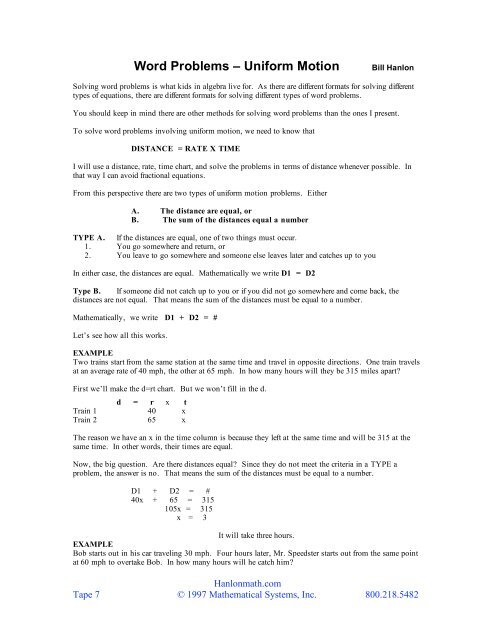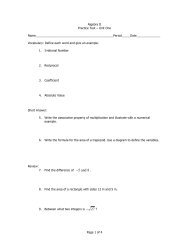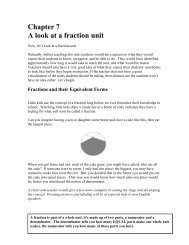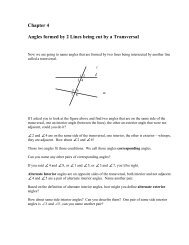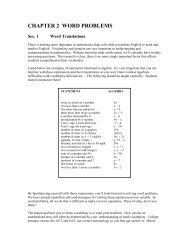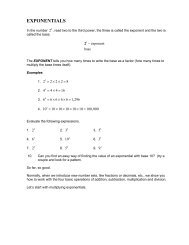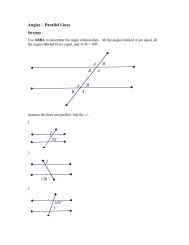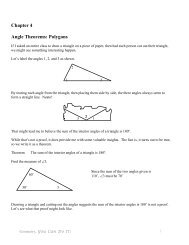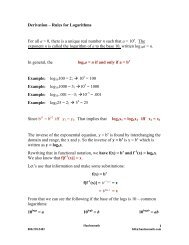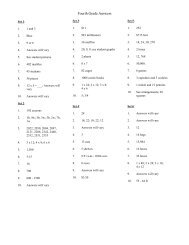Word Problems â Uniform Motion Bill Hanlon - Hanlon Math
Word Problems â Uniform Motion Bill Hanlon - Hanlon Math
Word Problems â Uniform Motion Bill Hanlon - Hanlon Math
Create successful ePaper yourself
Turn your PDF publications into a flip-book with our unique Google optimized e-Paper software.
<strong>Word</strong> <strong>Problems</strong> – <strong>Uniform</strong> <strong>Motion</strong><strong>Bill</strong> <strong>Hanlon</strong>Solving word problems is what kids in algebra live for. As there are different formats for solving differenttypes of equations, there are different formats for solving different types of word problems.You should keep in mind there are other methods for solving word problems than the ones I present.To solve word problems involving uniform motion, we need to know thatDISTANCE = RATE X TIMEI will use a distance, rate, time chart, and solve the problems in terms of distance whenever possible. Inthat way I can avoid fractional equations.From this perspective there are two types of uniform motion problems. EitherA. The distance are equal, orB. The sum of the distances equal a numberTYPE A. If the distances are equal, one of two things must occur.1. You go somewhere and return, or2. You leave to go somewhere and someone else leaves later and catches up to youIn either case, the distances are equal. <strong>Math</strong>ematically we write D1 = D2Type B. If someone did not catch up to you or if you did not go somewhere and come back, thedistances are not equal. That means the sum of the distances must be equal to a number.<strong>Math</strong>ematically, we write D1 + D2 = #Let’s see how all this works.EXAMPLETwo trains start from the same station at the same time and travel in opposite directions. One train travelsat an average rate of 40 mph, the other at 65 mph. In how many hours will they be 315 miles apart?First we’ll make the d=rt chart. But we won’t fill in the d.d = r x tTrain 1 40 xTrain 2 65 xThe reason we have an x in the time column is because they left at the same time and will be 315 at thesame time. In other words, their times are equal.Now, the big question. Are there distances equal? Since they do not meet the criteria in a TYPE aproblem, the answer is no. That means the sum of the distances must be equal to a number.D1 + D2 = #40x + 65 = 315105x = 315x = 3It will take three hours.EXAMPLEBob starts out in his car traveling 30 mph. Four hours later, Mr. Speedster starts out from the same pointat 60 mph to overtake Bob. In how many hours will he catch him?<strong>Hanlon</strong>math.comTape 7 © 1997 <strong>Math</strong>ematical Systems, Inc. 800.218.5482
Making the d = rt chartd = r x tBob 30 x + 4Mr. Speedster 60 xSince Mr. Speedster traveled the least amount of time, we called that x. This is a TYPE A problem, thedistances are equal.DBob = DSpeedster30(x + 4) = 60x30x + 120 = 60x120 = 30x4 = xIt will take 4 hours to catch Bob.<strong>Hanlon</strong>math.comTape 7 © 1997 <strong>Math</strong>ematical Systems, Inc. 800.218.5482


